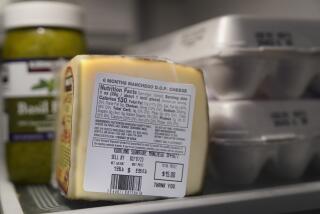Beer, like milk, is best enjoyed as fresh as possible
- Share via
The latest batch of Stone Brewing’s “devastatingly fresh” Enjoy By 4.01.13 IPA hits shelves this week, and the brewers are so serious about the freshness of their beer that they’ve built an April 1 deadline into the beer’s name. But why is it so important for this beer to be consumed within the 35-day freshness window?
Stone packs so much hops into their Enjoy By beer that they will pull it from retailer’s shelves 35 days after the beer was bottled to prevent anyone from buying a past-its-prime bottle. While well-brewed beer isn’t going to spoil if you leave it sitting around, it is a product that is best consumed fresh, and beer’s flavors and aromas begin to degrade just days after being packaged. You may have heard of people laying beer down, wine-like, to cellar, but only a small subset of beer styles will actually improve over time. The vast majority of popular beers, especially anything where the hops take center stage, should be treated more like milk than wine. Keep it cold and drink it promptly.
Time leads to oxidation, and this will dull a beer’s flavor. The first casualty will be the prized hop aroma and flavor, then the beer’s bitterness will begin to mellow, any spice or flavor additions will fade, and -- in extreme cases -- the beer can begin to develop off-flavors like wet cardboard. Keeping the beer cold will mitigate the effects, but the best defense against fading flavor is to avoid storing beer for much longer than a month or two.
Brewers vary in their suggestions for a beer’s shelf life, though between 90 and 120 days is the most common recommendation. You may never know how long a six pack has been sitting on the liquor store shelf, but thankfully more and more breweries are bottle-dating their beers. To ensure that you’re taking the freshest beer home, check the labels, bottle necks, or the bottom of cans for “bottled on” or “best by” dates, try to buy beer out of the refrigerated section, and avoid buying any dusty bottles of pale ale.
Local beer is usually fresher beer -- it shouldn’t spend as much time traveling or in warehouses -- and buying directly from the brewery is a great way to guarantee freshness. Growlers are a great option for fresh-from-the-tap brew at home, but it’s even more important to keep those filled growlers chilled. Don’t get stuck with old beer: Drink those hoppy brews if you’ve got them in your fridge, and watch for “best by” dates on the beer you’re buying.
ALSO:
More to Read
Eat your way across L.A.
Get our weekly Tasting Notes newsletter for reviews, news and more.
You may occasionally receive promotional content from the Los Angeles Times.








